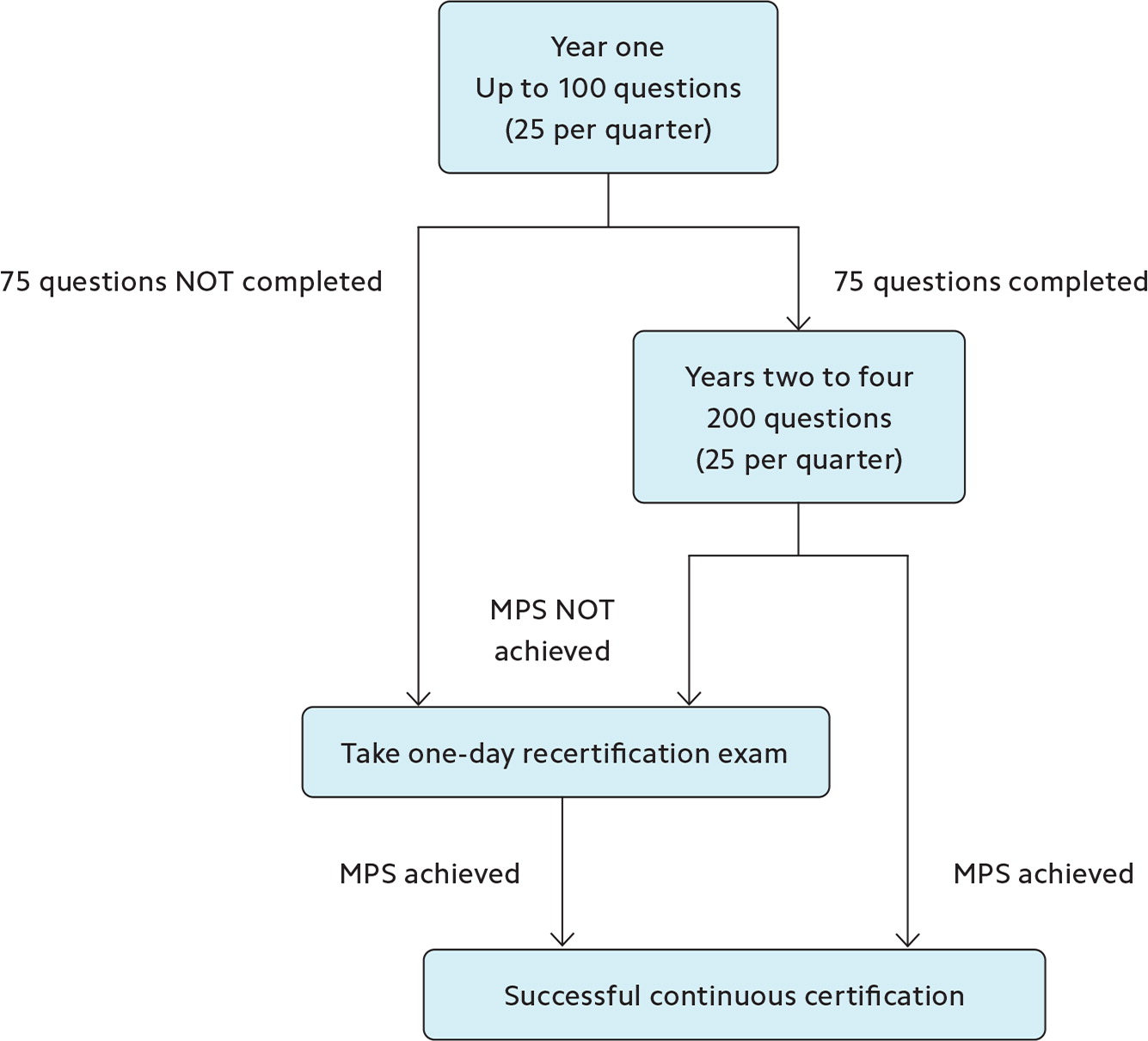
Family physicians now have a new pathway to renew their board certification — a “longitudinal” assessment versus the high-stakes, one-day exam.
Fam Pract Manag. 2022;29(5):6-11
Author disclosure: no relevant financial relationships.

This year marks an important milestone for family medicine physicians who have been involved in the maintenance of their board certification. Both MDs and DOs can now elect to forgo the high-stakes, one-day recertification exam and instead participate in a longitudinal assessment pathway. This pathway is offered by the American Board of Family Medicine (ABFM), which first piloted it in 2019, and the American Osteopathic Board of Family Physicians (AOBFP). This article will explore the evolution of maintenance of certification and review the requirements to successfully navigate this new pathway.
KEY POINTS
Physician recertification requirements have evolved over the years, with most boards requiring some sort of maintenance of certification and an exam.
Starting in 2022, family physicians seeking recertification with the ABFM or AOBFP can forego the high-stakes, one-day exam and instead take a “longitudinal” exam.
Despite its costs and hassles, board certification is a worthwhile pursuit for most physicians because of employer requirements, payer requirements, and expectations among the patient population served.
A LONG AND CONTROVERSIAL JOURNEY
To formalize a set of standards across specialties, physicians established the American Board of Medical Specialties (ABMS) in 1933 and the American Osteopathic Association Bureau of Osteopathic Specialists (AOA BOS) in 1939. Diplomates were issued lifetime certificates after passing their certification examinations. Another organization, the American Board of Physician Specialties (ABPS) was established in 1952 by a group of osteopathic surgeons who completed allopathic residencies and were not allowed to be board certified through the ABMS (because they were DOs) or the AOA (because they did not complete an osteopathic residency). Thus, they created their own certifying body and became the first organization to board certify both DOs and MDs in 1960.1
These organizations gave way to specialty specific certifying bodies, including the ABFM in 1969 and the AOBFP in 1972.
Medical knowledge in today’s world is far different than it was when the first board organizations were established. It is estimated that the doubling time of medical knowledge in 1950 was 50 years, and by 2020 it was just 73 days.2 As patients and payers became concerned about doctors keeping up with the rapid changes in medicine, most boards transitioned from lifetime certification to time-limited certification. Time-limited certification eventually became accompanied by continuous assessment programs called maintenance of certification (MOC). The ABFM’s MOC requirements began in 2004.
Developing these MOC programs became a challenging process that also came with controversy. Beyond being expected to possess a satisfactory fund of medical knowledge, physicians were now being asked to complete practice modules, earn CME credits, and submit practice improvement data. These newer requirements had additional expenses and hassles, which were compounded by the fact that physicians were still required to take and pass recertification examinations as well. This frustrated many physicians and became a rallying point for approximately 20,000 internal medicine physicians who signed a petition of protest in 2014 against the American Board of Internal Medicine (ABIM). This led to the establishment of the National Board of Physicians and Surgeons (NBPAS) in 2014, which would provide an alternative recertification pathway. The NBPAS criteria for recertification do not involve a recertification exam or continuous assessment. Its requirements include previous ABMS or AOA certification, earning a minimum of 50 CME credits within 24 months of recertifying, a valid and current medical license, and (if applicable) possession of hospital or outpatient facility privileges and maintenance of medical staff appointment/membership for at least 24 months.3
The long-established ABPS was another alternative for physicians to consider because it also does not require MOC. It does, however, require its diplomates to take a recertification exam every eight years and complete 400 CME credits (200 in family-medicine-related topics) and medical ethics training.4
With physician sentiment growing in an increasingly negative way,5–6 coupled with competitive pressure, the process of continuous assessment needed to undergo further evolution. The American Board of Anesthesiology (ABA) was one of the first to change its recertification process in 2016. Known as MOCA 2.0, it eliminated the recertification exam (as well as a simulation exam requirement) and replaced it with quarterly questions to be completed anytime on multiple digital platforms.
The journey for family medicine physicians followed a similar path of evolution.9–10 (See “Family medicine board certification over the years.”) The path would eventually lead to significant changes to the recertification process in 2022 for both the ABFM and the AOBFP. Let’s take a look at the new requirements.

ABFM RECERTIFICATION TODAY
The process of recertification for the ABFM requires diplomates to complete the continuous requirements in three-year stages. Each three-year stage still requires the following:
A current medical license,
150 attested CME credits,
50 certification points.
The certification points are earned through Knowledge Self-Assessments (KSAs), Continuous Knowledge Self-Assessments (CKSAs), National Journal Club activities, and performance improvement. KSAs include answering a 60-question assessment on a particular subject area, of which 80% must be answered correctly. These are untimed questions with opportunities to review missed questions, resubmit new answers, and provide commentary to each question. Alternatively, diplomates can choose from self-assessment activities sponsored by the American Academy of Family Physicians (AAFP), American Board of Pediatrics (ABP), and American Board of Emergency Medicine (ABEM). CKSAs include answering 25 questions per quarter. The questions are untimed and not graded. Diplomates can review how others answered the same questions, review references, and provide feedback. Both KSAs and CKSAs count toward CME credits, with 8 CME credits for each KSA completed and 2.5 CME credits for each CKSA quarter completed.
In addition to the above requirements, every 10 years diplomates must complete an exam — either the high-stakes, one-day recertification exam or the new longitudinal exam, called the Family Medicine Certification Longitudinal Assessment (FMCLA).11 This longitudinal exam includes 300 questions to be completed over a four-year time period (or as early as three years). It involves 25 questions each quarter (open book), and diplomates are given five minutes to answer each question. Answers cannot be changed once submitted. Immediate feedback is given for each question answered, along with an explanation and an opportunity to provide commentary. In order to “meaningfully participate” in the FMCLA, the diplomate must complete at least 75 questions in year one. If they do not, then they must take the one-day recertification exam. Once the diplomate reaches year two, they have until the end of year four in order to complete all 300 questions. Throughout this process, the diplomate maintains certification. (See “ABFM longitudinal assessment process.”)
Scoring for the FMCLA is not provided until after the first year of completion. An estimated score is then provided and updated each quarter to monitor progress. The final score is provided once all 300 questions are completed, known as the “preliminary” or “raw” score. This raw score is changed to a scaled score between 200–800, as the scaled score adjusts for the difficulty of exam questions received. (Each examinee may receive a different set of questions.) The minimum passing score (MPS) is determined after everyone participating completes the FMCLA. If the diplomate does not meet the MPS, then they must take the one-day recertification exam.

AOBFP RECERTIFICATION TODAY
Continuous certification under the AOBFP requires the following:12
An active medical license,
120 CME hours every three years,
Completion of a Practice Performance Assessment.
For diplomates whose certification expires in 2022–2026, the Practice Performance Assessment involves the completion of four activities, three of which are modules sponsored by the American College of Osteopathic Family Physicians (ACOFP) and the National Board of Medical Examiners (NBOME). The fourth activity is an attested quality improvement (QI) project. Completion of these modules provides Category 1-B AOA credit. This changes for diplomates whose certification expires in 2027–2030, with a requirement of just one activity (module or QI project) completed every three years to complete the Practice Performance Assessment.
The final component is a cognitive assessment. Instead of having to take the high-stakes, one-day exam every seven to nine years, all diplomates whose certification expires starting in 2022 will instead participate in a longitudinal assessment cycle. This assessment consists of 10 open-book, untimed questions per quarter for three quarters, with a passing score of 80%. There is a one-quarter remediation for incorrectly answered questions. If the diplomate does not meet the 80% pass requirement, they must take the recertification exam. (See “AOBFP longitudinal assessment process.”) According to the AOBFP, the recourse to take the recertification exam in the event of failing the longitudinal assessment will be unavailable for diplomates with 2027–2030 certification expiration dates. Completion of the longitudinal assessment also provides Category 1-B AOA credit.
Since Jan. 1, 2020, AOBFP diplomates have had an option to maintain or forgo OMT as part of their family medicine certification. To maintain OMT certification, participants must pass a performance exam or complete 12 hours of OMT hands-on training courses approved by the AOBFP every nine years. The performance exam must be taken in the last three years of certification and is offered twice per year onsite at an osteopathic medicine conference.

SHOULD I MAINTAIN CERTIFICATION?
Offering an alternative to the family medicine recertification exam is a welcome change long overdue. However, board certification is not a requirement to practice medicine but is voluntary, and many physicians question whether they should maintain their board certification through such a rigorous process. With the additional cost and time investment to maintain certification, it is understandable that physicians may still be hesitant to keep their board certification up to date. Several factors play a role in deciding how important board certification is to a physician. Payers and hospitals, along with multi-specialty medical groups, may require board certification. Some will be specific about which board organizations they will accept. For some physicians, not being board certified may not make a difference at all depending on where the practice is located or the nature of the practice. Or perhaps a physician has a direct primary care practice and has chosen not to continue maintenance of certification because it doesn’t affect their practice. Patients themselves may prefer a board-certified physician taking care of them, and this could be used by board-certified physicians to advertise and grow their practice.
The choice to remain board certified, and which organization to be certified through, is dependent on multiple factors, including time and cost, employer requirements, payer requirements, and the expectations of the patient population served. Knowing what to expect in 2022 and beyond should help physicians weigh the pros and cons of recertification and make the best decision for themselves.
